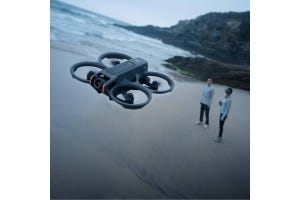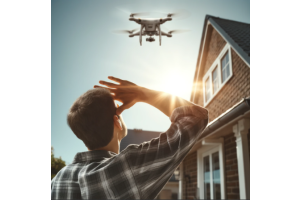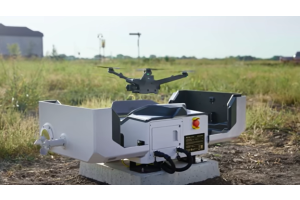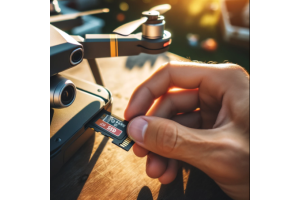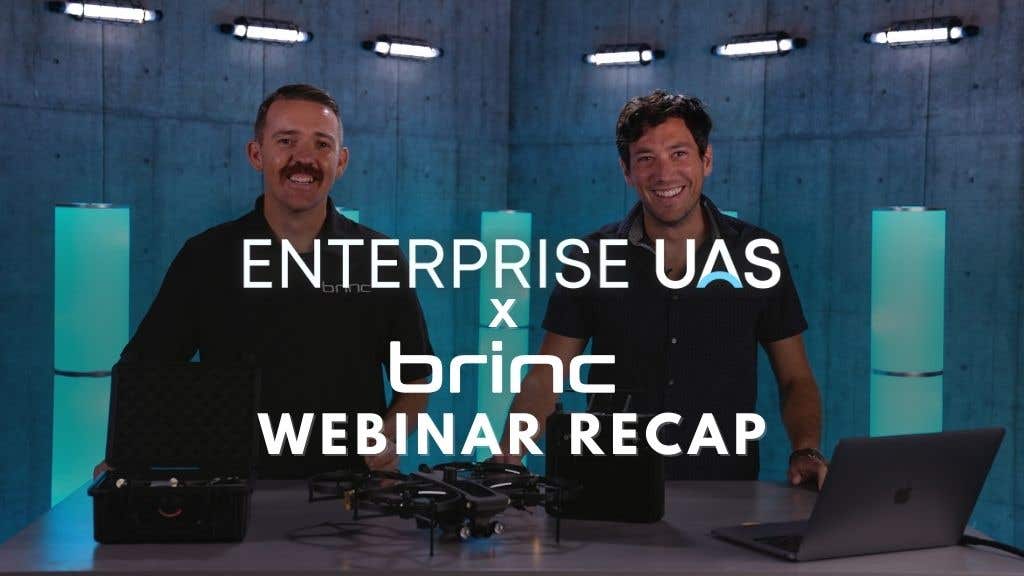
Recently, Randall Warnas, Executive Vice President of DSLRPros parent company EnterpriseUAS met up with Brinc Drones Director of Strategic Sales Steven Butler for an in-depth discussion on the Lemur S drone.
With the Lemur S, BRINC is bringing to market a rugged and capable unmanned aircraft system designed specifically for public safety applications. If you missed out on the webinar, you can watch the video below.
The transcript of their discussion (edited for length) is provided beneath the video.
Webinar Transcript (edited for length):
RANDALL WARNAS: What's going on everybody? This is Randall Warnas with Enterprise UAS. It has been a long time since I've been in front of a camera and a long time since I've been interacting with the audience of people wanting to learn about drone stuff. So, today, we have a special guest from Brinc. We're going to be talking about public safety and tactical use of drones. But before we do that, I want to say a few things. First, I want to say thank you to Mike Wilson and Jeremy Weiss, who've been behind the scenes, making this all come together and look good. Also, I want to say to Brett Kanda, who was going to be my guest, I hope he gets better. He came down with laryngitis yesterday. So we are doing this with my guy, Steven Butler. So let's kick this thing off. Let's go. So you want to introduce yourself first and then I'll introduce myself second.
STEVEN BUTLER: Yeah, sure, sure. So my name is Steven Butler. I am the Director of Strategic Sales here at Brinc rones. I have been with the company now, almost eight months. I’m fairly new to the drone industry, really been dealing with it for about the last three years or so. Prior to this, I worked with a law enforcement tactical distributor not too far from where we are right now and I spent nearly 12 years there. While there, I had the opportunity to deal with some of the nation’s best SWAT teams all across the country. And really got to understand kind of, what their capability gaps are, and where we can fit them in with some new product to help save lives. So I'm very blessed to have had that opportunity. Very excited to be a part of this program here. Now with Brinc Drones and just really looking forward to today.
RANDALL WARNAS: Yeah, well, you looking forward to it, you knew about 12 hours ago that you were going to be doing this filling in for Brett. So I appreciate you pulling out the stops that we’re in Los Angeles right now. You live here. I flew in and we're, we're trying this in the first, for the first time in a studio. So, if there are any hiccups just know that we're, this is our growing pains as we learn through this, but I'm Randall Warnas. I've been with Enterprise UAS for a very short amount of time, almost two months, but I've been in the drone industry since 2014 and cut my teeth with time establishing DJI Enterprise back in 2015. I went to FLIR and was running their global Drone business for about four years. And then had a weird stint over the last year with, Autel and with Atlas UAS. But, really, my passion is working with end users, and trying to get this technology in the hands of people that can use it to do the most. And, when we're talking about saving lives, we're talking about shortening the mission times for our public servants. That's one of the best use cases I can think of for this technology. So I'm grateful to be here. Grateful for everyone that tuned in and hopefully we'll be doing some education over the next 45 minutes or so. So Brinc as a whole came together as a company wanting to provide solutions for public safety directly. Drones are being used by public safety entities throughout the country and throughout the world. And we have some numbers here that show that there's a sizable number of police officers. In your estimation, what are these police officers doing with drones that is getting the most value and then what the Brinc really bring to the table as far as their mission.
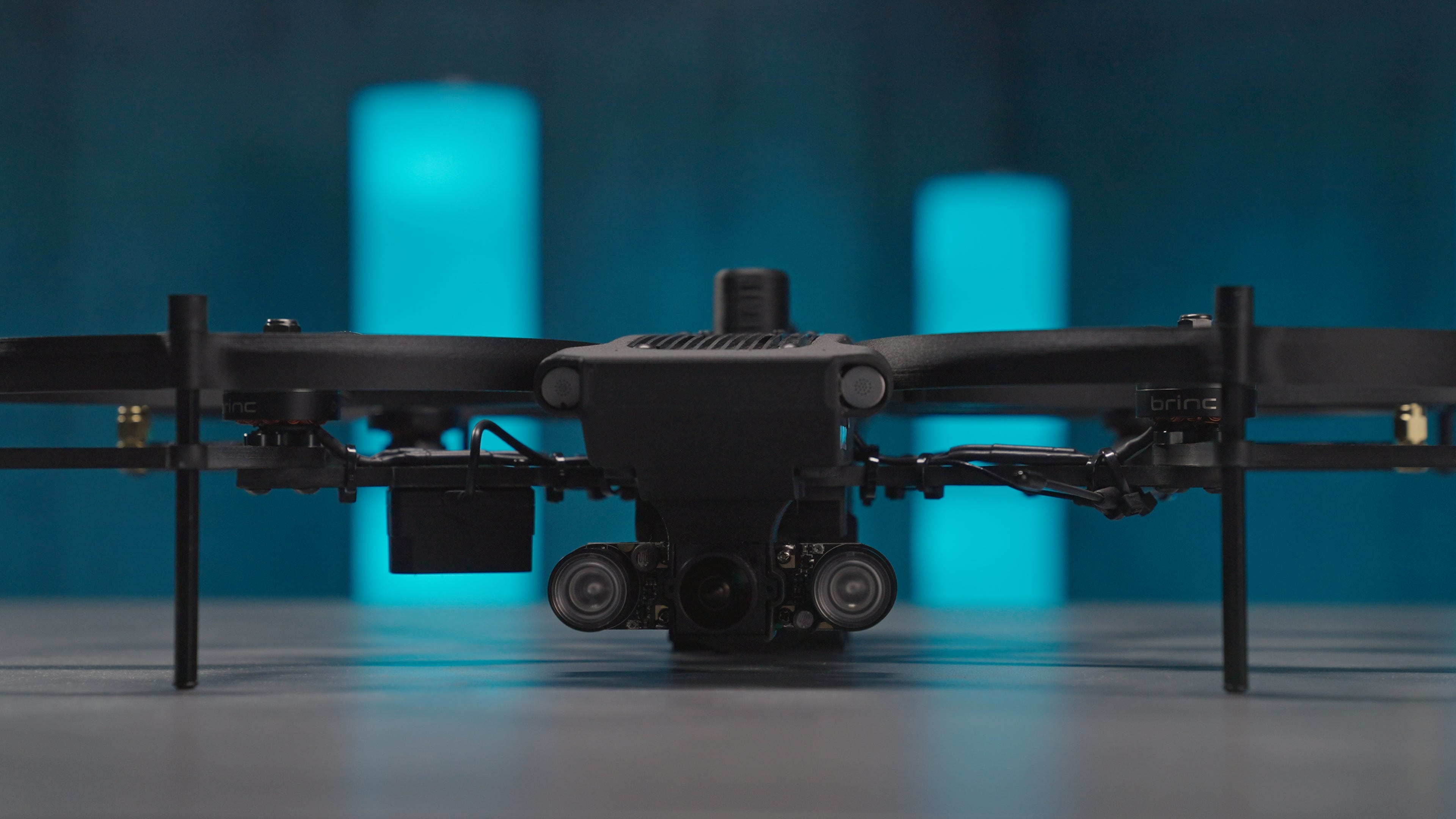
STEVEN BUTLER: Yeah, I think I'll answer the second one first. What really drove me to Brinc as a whole was kind of the way they came to market. It's very unique in this industry to identify an end user first and then design specifically to their capability caps. Right, and that's what we did here with Brinc drones. Our CEO, Blake Resnick, you know, at 17 years old, as you know. Unfortunately, the October 1 shooting happened in Las Vegas and it hit really close to home for him. So he knew that he had the capabilities in house and the know-how to build something that will keep these guys safe and out of harm's way. And so that was unique to me. Right? We understood that, you know. We identified a customer, public safety in particular, that very niche customer, which is our tactical space. And then, we design specific to that based on what their needs were.
RANDALL WARNAS: Yeah, and over the next bit, as we go through slides and talk about this presentation, we'll look at features, but Brinc’s mission to stay focused on that tactical user. I think that I'll ask a question that is just genuine to me. Like, when you have an airframe like this, most people expect to go outdoors and fly it out and open space. That's not the intention of the Brinc drone and is that, like, is there still a use case of doing outdoor flights or is that a completely different tool in the tool belt?
STEVEN BUTLER: Brinc Drones is very unique in that when you hear about Brinc drones, you just think of the Lemur S at this point, right? The reason for me coming onboard, obviously I think this is an amazing airframe that offers a ton of capability, is kinda what's next for Brinc, right? So, we've done an amazing job in the last eight months, even since I've been here, we've scaled this organization at a pace that I didn't think would be impossible. When I started, we were about 30 employees and we’re up to 80 now. We were just out of a Las Vegas office and now we've opened up a Seattle office where all of our R&D has taken place. So, I definitely see more airframes coming out for different capabilities for sure.
RANDALL WARNAS: I want to set the stage that this drone is not the drones you've seen. This isn't the commercial off-the-shelf stuff. There's not a lot of drones that do this. So, what we're going to be talking about is a very unique set of specs or tools that are on the airframe itself and then the use case who were building this stuff for is going to follow from what the drone is capable of. So I'm going to start off with a video, kinda just to set the scene. So we're going to be running this for a few minutes. You'll be seeing the video.
RANDALL WARNAS: So I'd like to think that showing a video like that answers all your questions. But, I do want to remind you that there is a question box within your dashboard. Put all the questions that you have in there throughout this entire discussion, and at the end, we'll be doing a question and answer. So, we'll be going through those at the end. Just make sure you have, if you have a question come to mind. You can, of course, e-mail us after or not let everybody enjoy the response and have that education as well. But if you give us the questions now, this lets everybody benefit from that. So, talk a little bit about, like you mentioned, the shooting in Las Vegas kind of being the precipice of everything. Kinda talk about the Brinc story. Like, why? What Blake saw, why, first response and specifically tactical SWAT teams are the focus.
STEVEN BUTLER: Yeah, so that particular incident, for obvious reasons, was what was, it was very hard for all of us to kind of see happen. You know, SWAT teams, they have a tremendous amount of capability, but within that particular incident, there were clear gaps within some of the capability that they have. You know, we're asking these guys to go downrange to gunfire every single day, and when there's a gap there, it is our responsibility, if we've got the capabilities in house to fill that gap. In its base form, and kind of go on this a little more, this is a flying camera, right? The idea is to get this inside of a structure before we send an actual officer there, we're trying to get SA, or situational awareness inside something, before we send anybody else. So that particular incident, it took about an hour for officers to get on scene, and they had to go down a long hallway. Terrestrial robots weren't working because there were potential booby traps, they obviously didn’t want to send anybody down there. So, Blake knew that he had the know-how and the ability to build something. And the hope is now this will fill that gap, might be able to send technology down and before, you know, a dog or a person.
RANDALL WARNAS: Yeah, before we go into, like, what the drone is actually made of, Brinc is a proud American made company. Is there any like NDA compliance, or or blue SUAS distinction on the path? Is it already done, like where does that all stand?
STEVEN BUTLER: So that's a really good question. So one of the other things that Brinc does very well, I think, is hire the right people in the right positions. There are subject matter experts across the board, throughout this company. So the blue and the NDA stuff is being worked on behind the scenes very hard, that is definitely something that we're looking forward to, and we have the right guys doing that.
RANDALL WARNAS: Perfect, amazing.There's obvious reasons, like what we're saying, where this drone is very unique. The use case is very unique. It's a US based company, but what are the other reasons that people would select a Brinc drone over maybe something else, Or, just how do they get to Brinc?
STEVEN BUTLER: Yeah, so, there's a couple of different reasons. One, I think, that in this space having been in it for so long. I think there's a lack of customer service within this space. Oftentimes there is a “Hey, we bought something, and then, you know, we forget you.” The follow ups and the customer retention portion, is something that just goes by the wayside. So we pride ourselves in that customer service portion of it being a local manufacturer here in the states, but you also have the ability at any given time to call anybody at any time and we're going to be able to support you and we're going to be able to send parts out of it. And just being an American made company, I think, goes a long way, for obvious reasons. Some of the other, commercial off the shelf ones that are from China, there's some issues here internally for you and all that later. But one of the biggest things is, you know, when it comes to federal grant funding, right, these agencies are always struggling with budgets, right? This is a $9,000 device that obviously is tremendously valuable, but not every agency across the country, which has $9,000 to throw down there, so the ability to utilize grant funds is something that is really important to them. And by being American manufacturers, they're able to utilize those grants with us.
RANDALL WARNAS: Just to piggyback on the support piece, I think that one thing that Brinc does very well is interact with the value added resellers, like Enterprise UAS is a consortium of resellers: Dronefly, DSLRPros and Aerial Media Pros. And basically, we interact with the customers, we’re the ones that put the devices in your hands. And when you need something, you'd rather maybe call us that maybe is down the street from you. Or, you know, we have guys dedicated to that than always known to the manufacturer. And so, with other joint manufacturers, that experience isn’t always really positive. Brinc has taken the right steps to make sure that you do have the right people, on the end of the line, to support you. And to make that a larger team they've set up resellers throughout the country to be able to handle those local customers.
STEVEN BUTLER: Right. And kind of piggyback off of that. In terms of resellers, we're very particular who we bring on board with us. Brinc as a company is making a lot of waves right now in all the good ways. With that, unfortunately, comes a lot of people wanting to be a part of it, right. And so when it comes to determining which resellers we have, we're very particular about it. One, we want to make sure that we have the right people there that are selling the right product and understand not only the drone’s capability, but also the public safety space as well, Right? We want them to be subject matter experts on our platform, right? But it's not even just the platform that drives us. It sprinkles an organization, right? There's so much more than just the hardware of it. And so the resellers that we have on board, we put them through our basic ground drone school that we have in Vegas. Everybody goes through that. They're very familiar with all of our text from top to bottom. We have an obligation as a manufacturer to directly support them at any given time, by way of our direct sales team. The other thing that we have, which is very unique to the industry, which I think is amazing, is we have what's called our SSG group, which is our strategic support group. And these are strategically placed individuals throughout the country that are all former law enforcement, with one firefighter, and they are there to support all of our resellers, do all of our face-to-face demos. And to be completely candid with you, some of the guys that we have on board, it's like building the dream team, right? We've got someone with 23 years just wide experience with someone, you know, who's been a sniper for X amount of years, these are really, really value add to our organization. And it's definitely differentiation in space.
RANDALL WARNAS: Definitely. Yeah. Alright. So let's talk a little bit about what you think is like the really killer stuff that's built into the airframe, the capabilities, and maybe some uses that maybe you haven't seen with other drones.
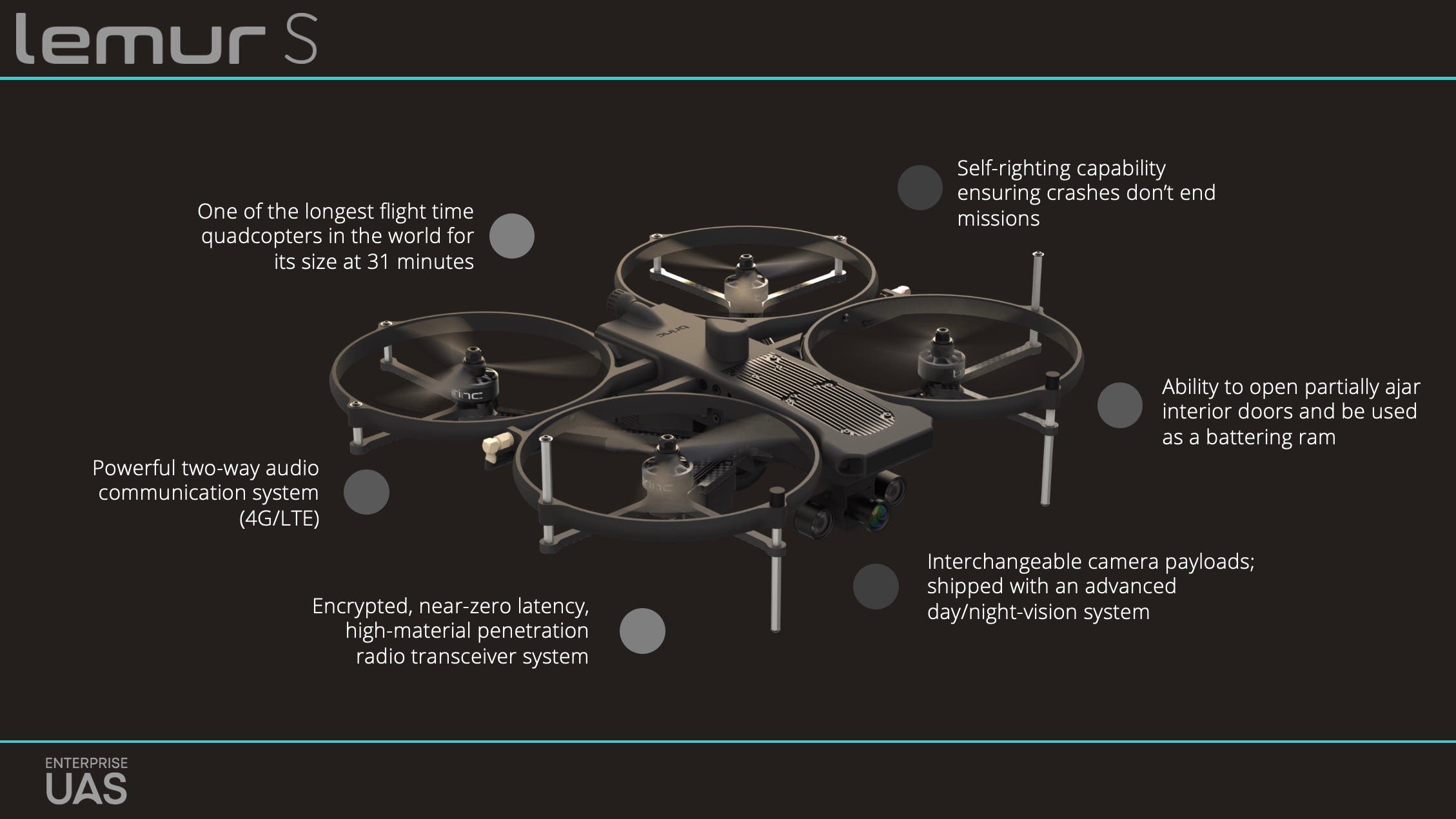
STEVEN BUTLER: Sure. Sure. So, you touched on earlier, this isn't your run of the mill commercial off the shelf UAS, right? We always make the joke that we can't think of a worse platform for overwatch and mapping and things like that just because it's specifically not built for that. Flying indoors is a very niche application. And there's a couple of things that you need to have on your airframe. One, you need to be able to work in GPS-free environments. That's extremely important when you need to be able to work in low light situations, right? And the other thing too is we need to be able to fly it wherever, whenever, right? Because if we're somewhere, and there's what's called a linear assault, you know, on a plane, or a bus or anything like that, we need to make sure that we can fly it inside at any given time. So, what I think, one of the main differentiation is, is that we don't have onboard sensors. There's no geofencing. There's no obstacle avoidance. So, that means you can take it off anywhere. We can take it off in the middle of a runaway in 45 seconds, every single time, and it's going to let you. Obstacle avoidance, as well. We make the joke that flying inside is a contact sport. It's really inevitable that you're going to hit walls. You’re going to be hitting tables, you’re going to be hitting chairs. In fact, we encourage that as well, because this thing is rugged and robust and is designed specifically to take a hit. So no obstacle avoidance and no GPS on that. We're all familiar with the, “Hey, let's get the bird in the air” and then you turn around and look at the guy, and he's doing the calibration dance, right. You're not going to do that here. The longest portion of this setup is just in putting the battery, and what I mean by that is we have a thumbscrew on the back here, and it takes about 30 seconds. So I really think that that is very unique to this space.The other thing I want to talk about, too is ,you can take a look at it right now, it is 3D printed and that is very intentional. One, we wanted to keep the cost down for the end users because we're very cognizant of what that bisect looks like, what kind of funding sources they have, So if we bring this to market for $30,000 or $40,000? Yeah, it's great, but I can't afford it, right? So how do we keep the cost down? Number one, that's 3D print it. But the other unique thing about it as well this is a nylon carbon fiber filament that we use, which is very, very strong, and very, very durable. In addition to that, it's very pliable. Why I really like that as opposed to an injection molded frame is once you take a hit or some type of impact, it's going to bear a lot of the weight, because it's actually going to bend with it as opposed to cracking.So you guys probably all seen videos online of people kicking this around. We ram it into doors and the walls on almost every single demo. It might take some hits. It might make a little scratch here and there. You might see the duct here kind of bend out of shape. But I think of it like an old baseball mitt, I'm just going to kinda form it back together.I would much rather have that than it actually crack.
RANDALL WARNAS: I think touching on the 3D printed piece is important because it does look different than most drones that you might have seen. What can you tell me about the hand controller?
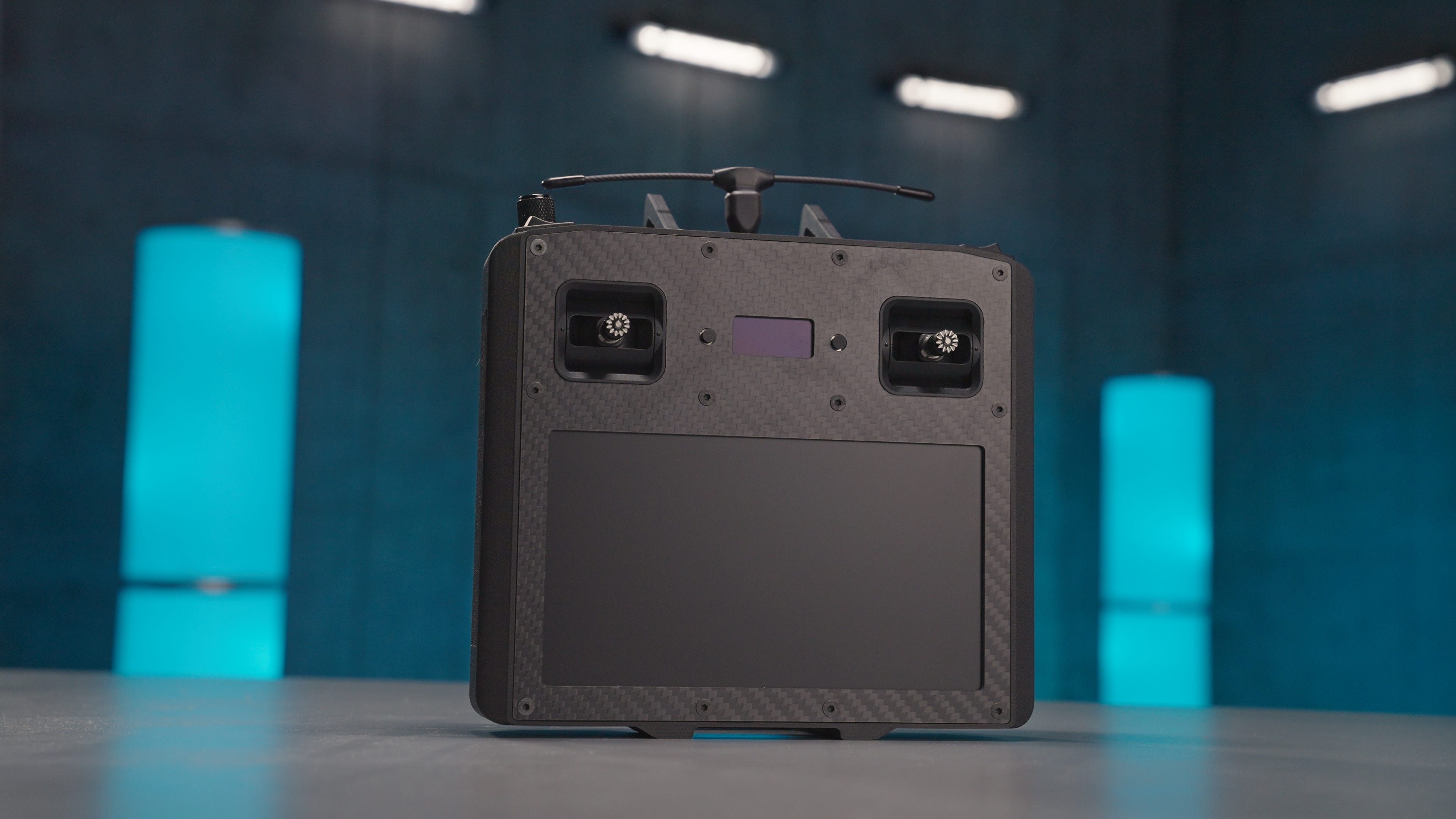
STEVEN BUTLER: It’s 3D printed as well. Utilizing some of the same materials that we have there. The form factor is completely intentional as well. We've got a seven inch screen on the front end. We're very focused on taking the cognitive load out of the operator as much as we can. The ability to fly from a piece of armor inside of, to a house, and within 50 to 75 feet, and the environment, with rain and wind. That's a real life application. We don't wanna have to worry about having to switch between different, you know, tilt angles and so on. So, everything's directly built into this, which makes it really easy to fly.
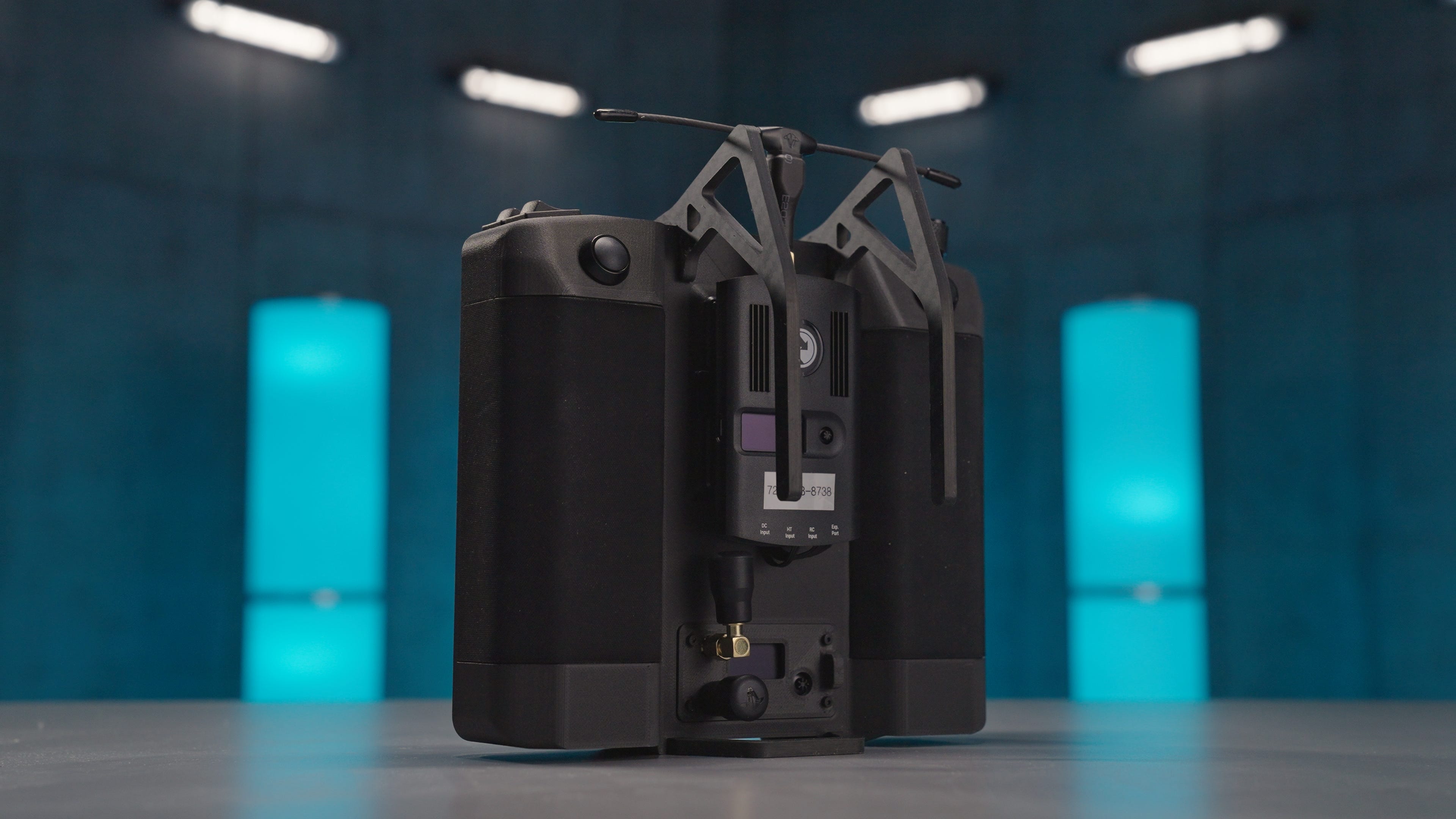
RANDALL WARNAS: So let's talk about the payloads. There is an accessory kit so that you can expand beyond just an airframe with a camera, to find people. Talk about those capabilities.
STEVEN BUTLER: I can pinpoint pretty much everything on this airframe and bring it back directly to an end user base of their feedback. Right? Blake had an idea as to what he wanted to do, but the first thing he did was try to meet with Las Vegas Metro after the incident, and said, Hey, what do you guys want? White sheet of paper. If you can build anything you can, what is it that you want? We talked about, you know, Non-GPS environments and being able to fly in low light situations, being able to do things like that, obstacle avoidance and so on.
One of the other things that they were really focused on is the ability to add additional payloads to the airframe itself. And this is our Lemur S. This is the second iteration. The previous iteration had payloads as well, but it just wasn't very quick. It wasn't easy. And now we have an onboard picatinny rail mount right here with onboard power. For those that don't know, picatinny is a very universal mounting system that you can find. So, now, all of our payload will attach directly to that by way of the picatinny rail. And a couple of ones I wanna kinda go over is we have everything directly integrated into this Pelican case with custom foam specific for that. So at night or in different situations, you can't put something where it's not supposed to go which is really nice.
I've mentioned that this works in conjunction with our payload dropper. We have a servo integrated right here. So you can use that with that. Another thing, too, is we always look at, you know, different types of applications. So CNT, or negotiation tactics. What can we do?

One of the main differentiations in our platform as well. It is a flying cell phone. One thing I was going to circle back to that, we have 4G on that, So you take any sim card that's on the market. You could throw it in there, it's got a phone number that's assigned to it, there's nothing fancy. You call it, you can call it from anywhere, and then you're having two-way communications with the suspect the entire time. Another thing for de-escalation, as that's the magic word right now, is once we've established communication, we might need to deliver something to help them. Either a pack of gum, it could be a cigarette, it can be granola, anything like that.
Another thing, as well, we have integrated IR on this, and it's just a toggle on our GCS, and it's a very, very powerful IR system that we have there. That allows us to fly from a perfectly well lit environment into a perfectly dark environment, being able to see very quickly.
In addition to that, we have a forward facing LED, a very powerful light, about 250 lumens. This works really well in conjunction with the IR and you can use this as like a designator. If you're flying into a room and be able to light something up. Some teams within the space, they don't have the ability to have night vision. So having a secondary light source by way of the IR is not something for them. So they will actually use this white light as a secondary source. One of the applications, and one of the teams have told us in a smaller residential building, It's so powerful. If you go into a small room, you can actually point it directly at the wall, it will reflect off the wall. And it illuminates the whole entire room, so they can continue to clear that and then move on after that.
And then the other one that we have here, which I'm sure most people are very familiar with us, this is our glass break, So this is very unique to the industry. This was designed with the end user in mind, 100%. One of the tactics that oftentimes we're using on the exterior structures of a building or inside of a car is we're trying to port the windows to deploy, you know, either chemical agent or anything like that to help with the situation.
So this is going to fly up to the structure. It's got to tungsten carbide lathes bits that that's been inside of this housing unit.
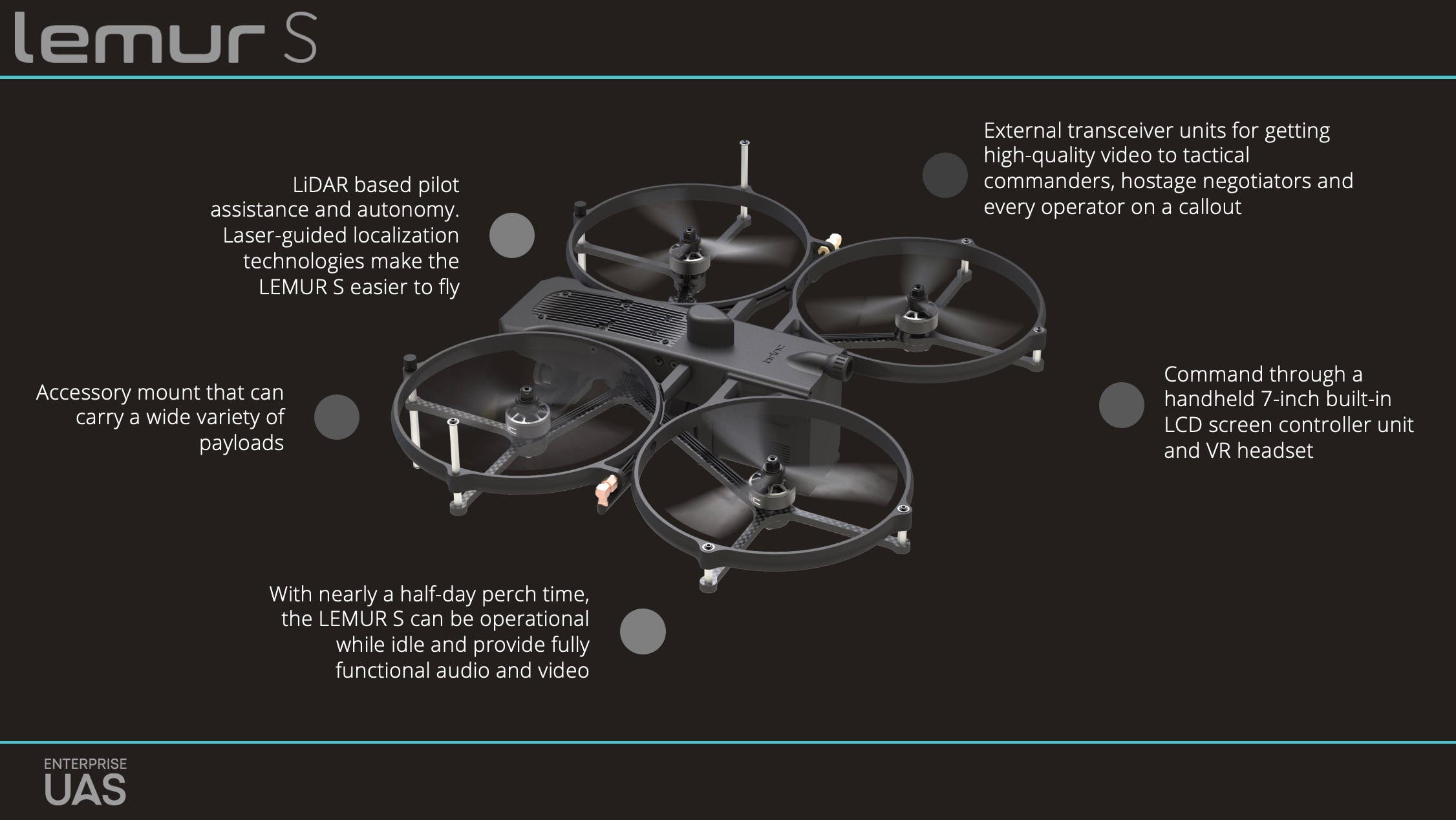
And all we're trying to do is we're trying to touch the top of it, it's going to kiss it slightly, and then all the shards are going to break underneath it. And, at that point, we can continue to fly the drone in. We can deploy gas from a tactical standpoint. There's a lot of different things we can do.
RANDALL WARNAS: Yeah. Usually when someone talks about payloads in the drone industry. It's like, what cameras do you have, and you guys clearly have gone beyond that to add things that are specific for tactical use cases.
STEVEN BUTLER: What we wanted to do, because we're definitely against weaponizing any type of drones, is we wanted to make sure that we put a protective shroud on the outside of it there, so that way, it's spinning on the inside of it. Therefore, you know, no one can potentially think it's a weapon. Someone can't grab it and hurt themselves. So now it's spinning within this protective shroud and that's been streamlined.
RANDALL WARNAS: So Turtle mode, yeah. This is not something that you can look at and be like, here's Turtle mode. You have to kind of see it work.So basically, you have the ability when a drone goes down to flip it over, kind of explain what cases that is used and how often it's used for?
STEVEN BUTLER: Yeah, yeah, so it's used quite a bit actually, and it's a very unique capability here. We mentioned flying indoors is a contact sport. So the chances of hitting a wall and falling over is very high. Now, we're aware of that and we wanted to make sure that just because it flipped over does not mean you're out of the fight there and we'd lost all capability. So yeah, on our GCS, there's a toggle. It just one switch all the way over. And it's going to operate the props in the opposite directions and it's going to force itself back over.
And then at that point, flip back into lidar or manual and then continue to fly and clear the structure.
RANDALL WARNAS: So door pushing, this is another thing that not most most drones are not designed to do.Talk about- Why is pretty clear but like what is the special capability that is there?
STEVEN BUTLER : We wanted to make sure that there was enough mass behind it, because we knew that the ability to push open a door is very important to us, because by sending tech to push in the door, that's obviously not having an operator directly on it there.
We have the ability to open doors that are slightly ajar. Obviously, there's no arm on that. You can’t actually twist anything, but if it's slightly ajar, then we can actually fly into it and push that door open, and continue to make progress throughout that structure.
RANDALL WARNAS: Like, you're talking about. The context for this is, contact the intentional contact in that contact sport, and if it did flip, or, if the suspects on the other side knocks that over maybe they don't even think about the drone reviving itself with the Turtle mode. So, there's a lot of things that when there's lack of awareness from the suspect of this technology, you have a significant advantage as well, because they're probably not thinking through all the specs are all the features you built-in.
STEVEN BUTLER: That's correct. That's correct. I just wanted to touch base on the battery real quick. Our battery chemistry is very powerful so we're getting upwards of 500 charge cycles on that which is very unique for the industry. The other thing too is we get amazing flight time. We're getting up to 30 to 31 minutes of constant flight time while clearing the structure.
When we land it or if it turtles, we have up to 10 hours of stand-by perch time at that point. And because it is a two-way communication device as well, we can actually sit there, call in to it, and the bad guy just thinks it's fallen over, but we can actually have passive listening the whole entire time.
Which is very unique. And we have onboarded recording as well. So we're recording both video and audio the whole entire time.
RANDALL WARNAS: Yeah, and and from Blake, being kind of a visionary person with building the technology as the CEO, I think that there's also these visionaries throughout law enforcement that see this, and they're like, well, could you do this? And it takes that question for us as an industry to build something for your needs, and I think Brinc is really listening to that.
STEVEN BUTLER: They listen to it great and Blake, let me just tell you, I wasn't doing what he's doing at 22. He's listening and he's building this direct link to user feedback. It's really cool to be a part of something like this.
RANDALL WARNAS: And you mentioned, earlier, the price point of the Lemur S. That's pretty rare in the drone area, as well, where you're like, this is our price. The fact that Brinc wants agencies to know what they're spending, and it's not like, get down the road and decide that you already want it and then you'll be informed of the price. It's not really a question, it's just commendable, it's commendable as a manufacturer to put that out upfront.
STEVEN BUTLER:Yeah, yeah, and to be candid with you it makes my job easier, right? I mean, pricing is fully transparent with us. You call into anybody, direct sales, any of our channel partners, And the prices are the same. You know, we actually, When we go to trade shows and we go to these events, we put price lists on the table. Nobody does that, right? Because you always ask somebody, Hey, how much does this cost me? Like, well, If you buy 10, if you buy 5, but that's not the case. And that was very intentional as well, early on.
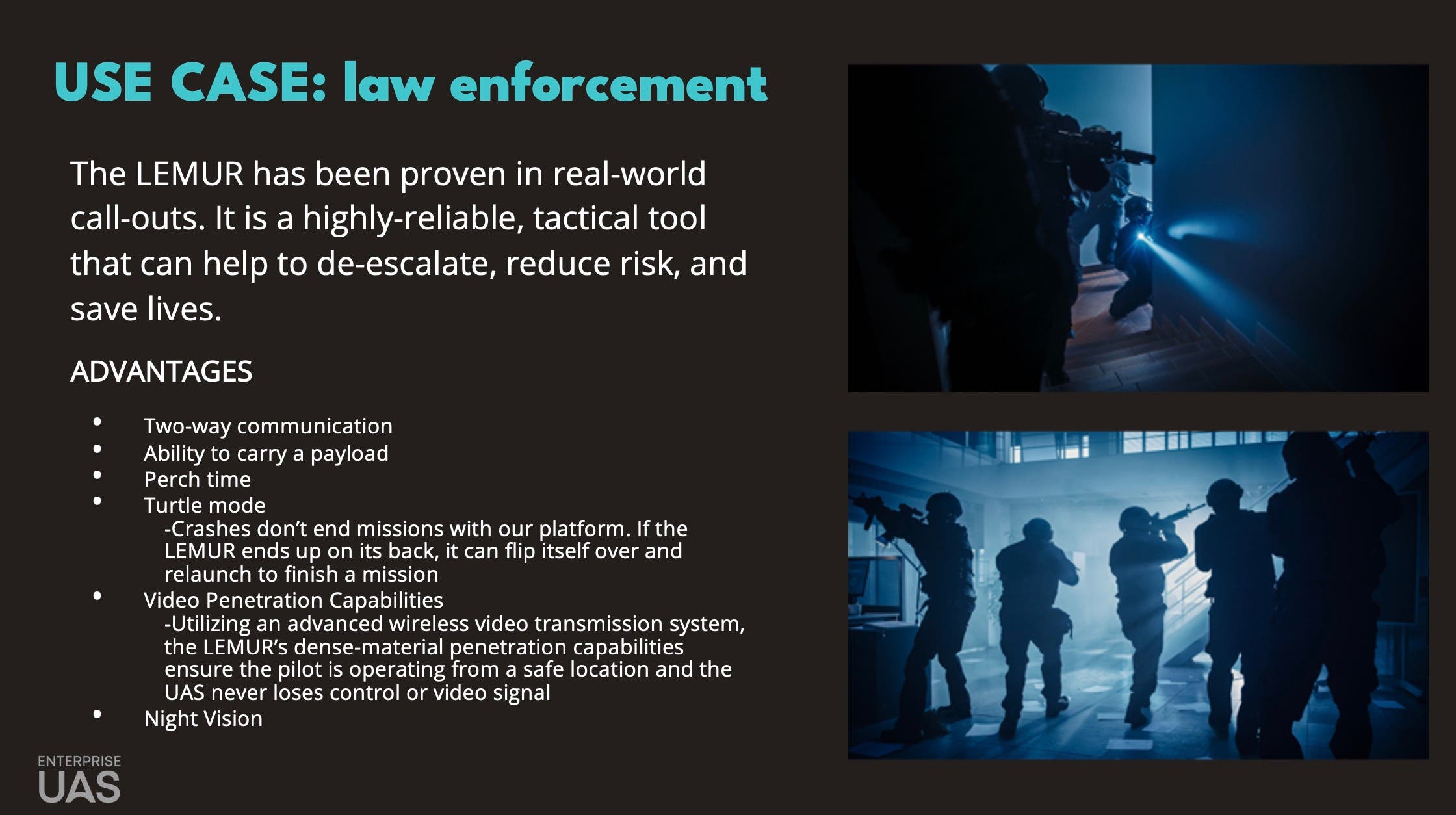
And, the sub $10,000 was very intentional, as well as the procurement process through most public safety entities, anything under $10,000, for most, it becomes fairly, I won't say easy, but it is easier to procure those at that point. We're pretty transparent and excited to offer that pricing,
RANDALL WARNAS: I just think that the amount of benchmarks that you're pushing the industry in the right direction to be more professional, have better support, show pricing, and you know, the transparency to your customers. Law enforcement appreciates transparency. Right. Communities appreciate transparency.
But I think that these are all things where it's like, pushing others to kind of see that and learn, that's the new normal, not what the other parts of the industry do.
STEVEN BUTLER: Yeah, I think it is the new normal, right? The consumer is changing, right? Our parents bought one way, we buy a different way.
RANDALL WARNAS: Let's jump into some use cases.
STEVEN BUTLER: Yeah, definitely, so, I mean, you get to see on the slide there. The two-way communication is definitely a massive differentiation in the space being able to fly in somewhere.
Obviously, you have video of what's going on, but the ability to have two-way communications is very unique, as well. I think the FBI came out and said, It's like a high 90% that you're going to resolve something peacefully if you were able to engage in communication early on. So, the fact that we have that powerful tool is amazing, and it definitely is a value add to the organization. So we're seeing that, oftentimes, our agency, to fly it in there, they'll perch on something just like we're doing here. That will have the ability to see and communicate within the whole entire space and help with de-escalation.
Again, we talked about the ability to carry payloads as well, that's another use case. We're seeing these used in many different ways. We went over, you know, the terrestrial robot mount, being able to put on top of an armor. So that way we can drive up to a structure closer, keeping the pilot behind armor, so that they're protected. You know, these things we're learning as we go. So it's, it's really nice.
RANDALL WARNAS: Yeah, and I think that's when we think about law enforcement. As a community. Maybe we think about it like bad guys, But this is also protecting good guys that maybe are just, you know, at risk for one reason or another. Right? And to be able to locate them and communicate with them. It's not only you know convincing someone to come out with their hands up, But it's also something else as well. Or, you know, if someone gets to go home safe.
STEVEN BUTLER: Absolutely, that's the idea behind this. We want everybody to go home and see their family. I've got a family myself with two boys and I am very passionate and blessed to be able to work for a company that provides this type of lifesaving capability. It's really unique.
RANDALL WARNAS: So let's talk about another type of user. And you mentioned on your team, You have one firefighter. So what is this being used in firefighting? How prevalent is that, and kind of just walk through the use case a little bit.
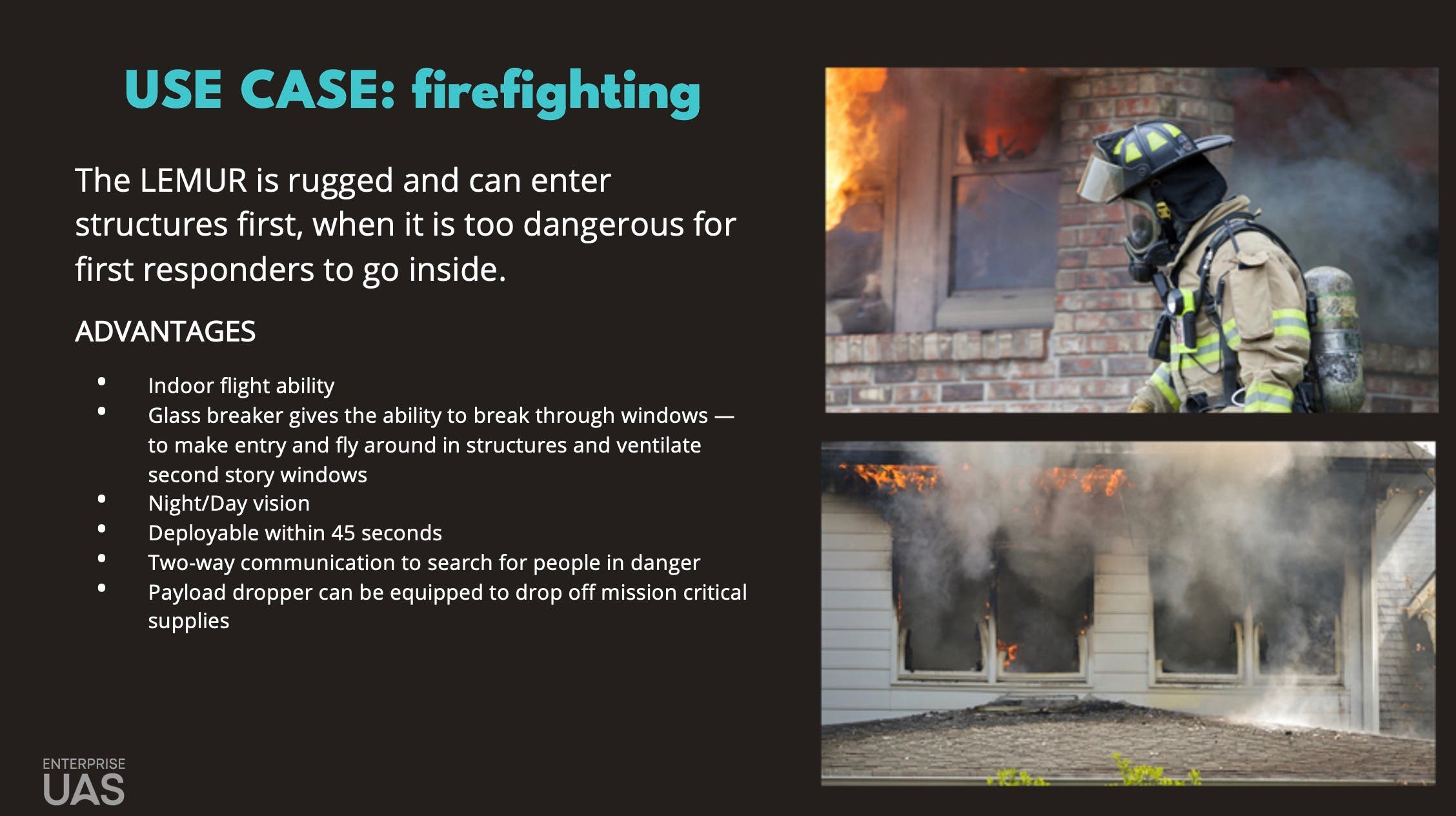
STEVEN BUTLER: Yes, so we're candidly where the beginning stages of that direct integration into the fire space, right. In addition to a standalone firefighter, there's also something that's happened in the last couple of years within the attack boards, a tactical space, right? They have something called TEMS which is to tackle emergency medics and these are firefighters that are directly integrated into the SWAT team. Oftentimes, they don't have weapons on them, but they're very familiar with their tactics. And, so, we're seeing some of the TEMS guys actually using this, and they might be the pilots in there as well. So, they might continue to clear structures. Another one to you, think of a burning building, You think of a burning car, and we have the glass break attachment right here.
You know, we're able to fly it up, break that window on the house, on the car, or whatever it is. And that helps with ventilation, for sure being able to get the flames out and smoke out is something that we're really excited about. And we're working with a lot of these local fire departments.
RANDALL WARNAS: So, here's something that's not specific to Brinc, but more to an industry. When you have a police department and a fire department that look over the same jurisdiction and drone programs exist in one, but maybe not the other. There's a lot of like, trading of secrets and sharing of equipment, right?
STEVEN BUTLER: Yeah, absolutely. You hit the nail on the head.
And oftentimes, funding comes from one of the other, right? So, only about 5 to 6 years ago, really, that integration started to happen. They were standalone entities for so long, and now we're starting to see them integrate and we're starting to see them, you know, either share funding sources or the fire department, having one in the PD, having the other one.
RANDALL WARNAS: So we also have search and rescue that was brought to mind, as far as what the Brinc technology can do. Where is that helpful?
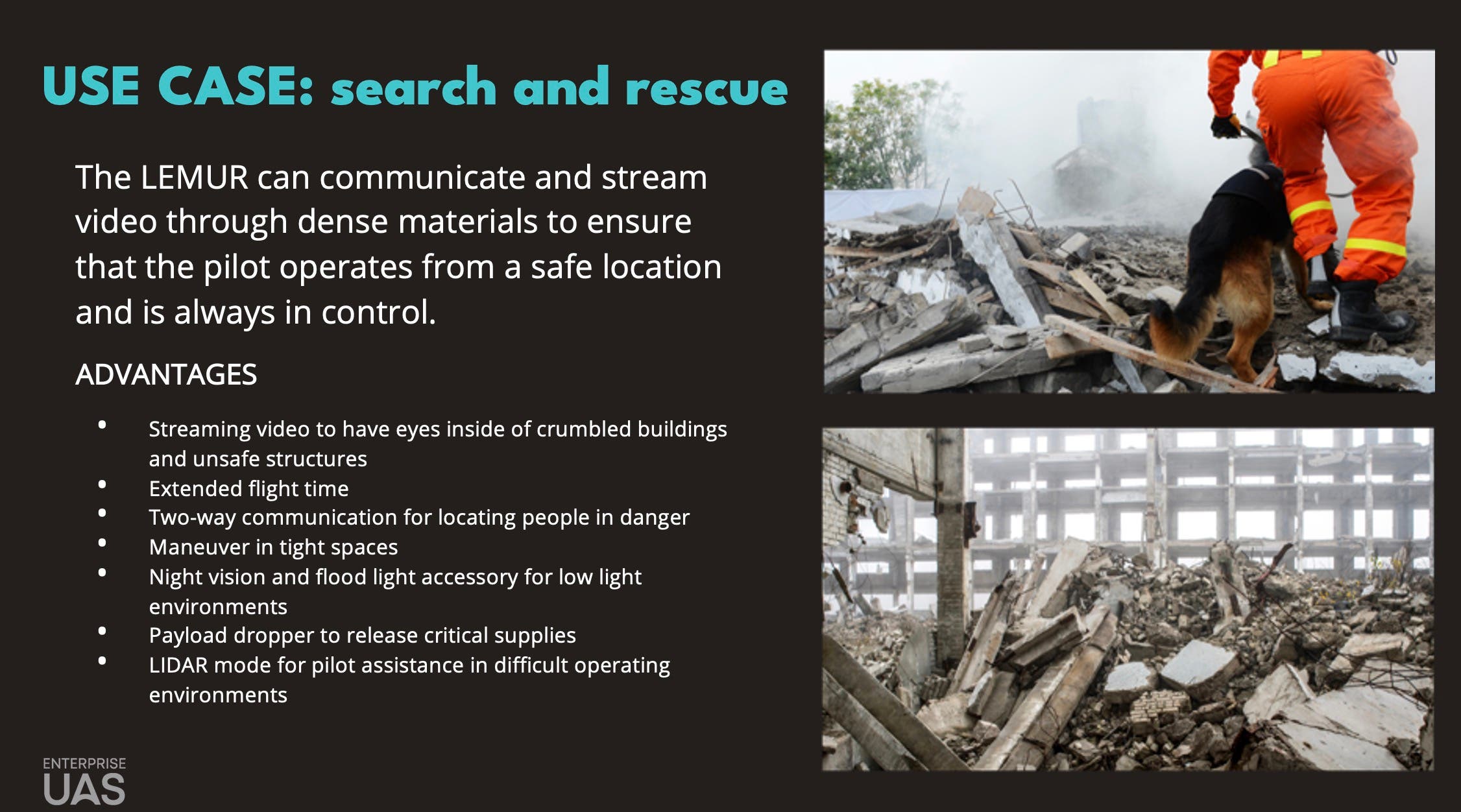
STEVEN BUTLER: Yeah. So we all remember the Surfside collapse a few years ago. With that condo coming down, we were actually one of the only drones to go out there and be able to fly underground to check the integrity of the structure. There's a couple of ways we were able to do that. One,we have the integrated night vision on it there. We didn't mind hitting some of the debris that was down there.
But we also went off an analog based system, which helps a whole lot with signal penetration, right? So, although it might be slightly pixelated on or GCS, when you're pulling that feed back down, it is full 1080P.
So we were able to actually clear, down below, pull it back, and take a look at the footage and be able to determine whether or not this portion of the building is, you know, safe for people to go in. Or if there's any type of debris in the way that will prevent our search and rescue going in to saving lives.
RANDALL WARNAS: Tell me what things you guys have considered as far as evidential storage.
STEVEN BUTLER: So, the Lemur S is very unique, in that, It gives you the option to record or not record. The way we record both video, and audio, is by way of a micro SD card. There's a slot on this side of the fuselage there at the moment. When you supply power for it it's automatically recording all video and audio.
So why that's important is if there's a mission and we're flying through this structure and there was some sort of evidentiary things that we need to pull down. We can pull that down by putting that into a secondary viewer monitor, a computer or anything like that and it's all 1080P.
The reason why we give the option to record or to not record is there's still some agencies, depending on where you go that will not let you record anything. There's different laws and things that are set up that say, Hey, you know what? There's some eavesdropping issues there and we can't record anything, but we still want to have the ability to fly inside and have a camera inside. So we've got that option of recording or not recording,
RANDAL WARNAS: OK. And then, what about Hazmat? How is this being used? Or, what is the future of the vision of how the Lemur S can be used for Hazmat?
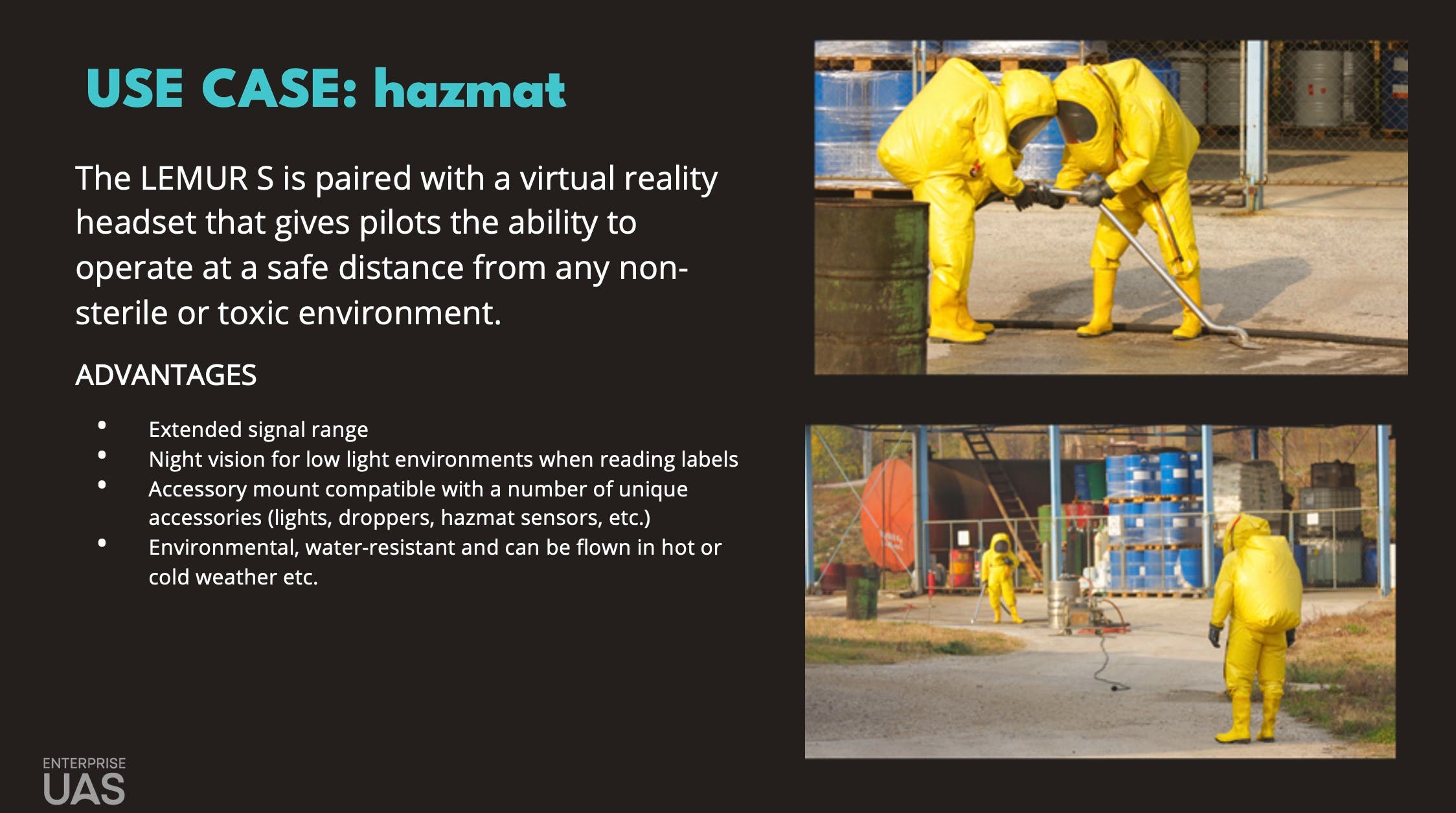
STEVEN BUTLER: We're still very early on in this. We've worked with some third party organizations to see how this thing performs in different situations. We have the payload dropper, so we're looking at the ability to drop sensors inside. So this is something that we're really excited about and I think we'll have a lot of integration here shortly with them.
RANDALL WARNAS: How can people get in touch with people that have hands-on experience to kinda give their feedback on the product as well?
STEVEN BUTLER: Yeah, That's a really good question. So we've got a couple of different options that are set up. Obviously, we're all set up with all the social media outlets. We have our own LinkedIn page. You can go directly to our website. You can reach out to any of our channel partners like you guys. But the other thing that we do too is, if there's a local agency that is already deploying this and you want to call them for feedback, we're all about that. We'll provide you with the POCs information once it's approved by them, and we'll let you talk to them. And then, they'll give you the good, the bad, and the ugly of it. And to us, it's really important. So, those couple of different outlets are ways for you to figure that out.
RANDALL WARNAS: And I think that the most important way for you to understand what this product is, is to see yourself.
So, one thing that's really cool about Brinc, is they send people everywhere to go and do demonstrations for your department, for you to bring in, you know, mayor, governor, Senator, accounting person down the hall, the person with the purse strings, or your entire department. What we want to do is have more people experience what the Lemur S can do. Even if you're not a buyer today, or you're just starting your drone program, and you have a few, you know, smaller off the shelf drones. This is the future to public safety, keeping communities safe, and for you to see it firsthand, and to have it be part of the conversation.I guess it's as easy as contacting either us at Enterprise UAS, and I have some e-mail, and phone number there. Or you could be contacting Brinc directly, but really what we want to see is just more people putting their eyes on the product, giving feedback that could be built into making the solution of the future, and also to go out and save lives and protect your communities.
STEVEN BUTLER: Yeah, that's a good call. Reach out to Randall and his crew and we’ll support a demo. We want this in, everybody's hands.
RANDALL WARNAS: So, again, sales@EnterpriseUAS.com, also sales@DSLRPros.com works as well or randall@enterpriseuas.com to reach out to me if you have any interest in scheduling a demo or if you have any questions on the drone front as a whole, randall@enterpriseuas.com. This is Stephen Butler, my guy at Brinc. Thank you.
STEVEN BUTLER: My pleasure. Thanks for having me.
RANDALL WARNAS: Until next time.
STEVEN BUTLER: Be safe everyone.
RANDALL WARNAS: See you.
For more information about the BRINC Lemur S, visit DSLRPros or email sales@dslrpros.com.

